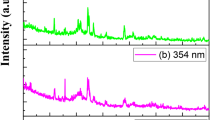Abstract
P-type ZnO:N films have been grown successfully by chemical vapor deposition (CVD) using Zn4(OH)2(O2CCH3)6 · 2H2O as the solid source material and ZnNO3 as the doping source material. XPS, Hall-effect measurement and PL spectra were employed to analyze the structural, electrical and optical properties and study the influence of substrate temperature on the film. Results showed that with a lower substrate temperature, the film exhibited p-type conduction and its resistivity decreased when the substrate temperature increased. When the substrates temperature was 400°C, p-type ZnO films were obtained with carrier concentration of +5.127×1017 cm−3, resistivity of 0.04706 Ω · cm and Hall mobility of 259 cm2/(V · s); they still exhibited p-type conduction after a month. When the substrate temperature was too high, the film was transformed from p-type to n-type conduction.
Similar content being viewed by others
References
Tsukazaki A, Ohtamo A, Onuma T, et al. Repeated temperature modulation epitaxy for p-type doping and light-emitting diode based on ZnO. Nature Mater, 2005, 4: 42–46
Yan Y F, Zhang S B, Pantelides S T. Control of doping by impurity chemical potentials: Predictions for p-type ZnO. Phys Rev Lett, 2001, 86(28): 5723–5726
Lu J G, Ye Z Z, Zhuge F, et al. P-type conduction in N-Al co-doped ZnO thin films. Appl Phys Lett, 2004, 85(15): 3134–3135
Li X N, Brian K, Sally A, et al. Hydrogen passivation effect in nitrogen-doped ZnO thin films. Appl Phys Lett, 2005, 86(12): 122107
Liu W, Gu S L, Ye J D, et al. Blue-yellow ZnO homostructural light-emitting diode realized by metalorganic chemical vapor deposition technique. Appl Phys Lett, 2006, 88(9): 092101
Lu Y F, Ye Z, Zeng Y J, et al. Effects of RF power variation on properties of N-doped p-type ZnO thin films grown by plasma-assisted MOCVD. Opt Mater, 2007, 29(12): 1612–1615
Lu J G, Fujita S, Kawaharamura T, et al. Roles of hydrogen and nitrogen in p-type doping of ZnO. Chem Phys Lett, 2007, 441(1/3): 68–71
Peng X P, Wang Z G, Song Y, et al. Structural and photoluminescent properties of ZnO films deposited by radio frequency reactive sputtering. Sci China Ser G-Phys Mech Astron, 2007, 50(3): 281–286
Zhao J, Hu L Z, Liu W F, et al. Properties of ZnO thin films grown on Si substrates in vacuum and oxygen ambient by pulsed laser deposition. Appl Surf Sci, 2007, 253: 6255–6258
Lu J G, Ye Z Z, Huang J Y, et al. Synthesis and properties of ZnO films with (100) orientation by CVD. Appl Surf Sci, 2003, 207(1/4): 295–299
Dai L P, Deng H, Chen G, et al. Growth of a-b-axis orientation ZnO films with zinc vacancies by SSCVD. Vacuum, 2007, 81(8): 969–973
Lin B X, Fu Z X, Jia Y B. Green luminescent center in undoped zinc oxide films deposited on silicon substrates. Appl Phys Lett, 2001, 79(7): 943–945
Cho S, Ma J, Kim Y, et al. Photoluminescence and ultraviolet lasing of polycrystalline ZnO thin films prepared by the oxidation of the metallic Zn. Appl Phys Lett, 1999, 75(18): 2761–2763
Zhang D H, Xue Z Y, Wang Q P. The mechanisms of blue emission from ZnO films deposited on glass substrate by r.f. magnetron sputtering. J Phys D: Appl Phys, 2002, 35: 2837–2840
Zúñiga-Pérez J, Muñoz-Sanjosé V, Palacios-Lidón E, et al. Facets evolution and surface electrical properties of nonpolar m-plane ZnO thin films. Appl Phys Lett, 2006, 88(26): 261912
Morhain C, Bretagnon T. Internal electric field in wurtzite ZnO/Zn0.78Mg0.22O quantum wells. Phys Rev B, 2005, 72(24): 241–305
Koida T, Chichibu S F, Uedono A, et al. Radiative and nonradiative excitonic transitions in nonpolar (11–2 0) and polar (0 0 0–1) and (0001) ZnO epilayers. Appl Phys Lett, 2004, 84(7): 1079–1081
Zeng Y J, Ye Z Z, Xu W Z, et al. Study on the Hall-effect and photoluminescence of N-doped p-type ZnO thin films. Mater Lett, 2007, 61: 41–44
Author information
Authors and Affiliations
Corresponding author
Additional information
Supported by Chengdu Science and Technology Project (Grant No. 07GGYB572GX) and Fund of State Key Laboratory (Grant No. L08010301JX0615)
About this article
Cite this article
Mao, F., Deng, H., Dai, L. et al. High quality p-type ZnO film growth by a simple method and its properties. Chin. Sci. Bull. 53, 2582–2585 (2008). https://doi.org/10.1007/s11434-008-0357-7
Received:
Accepted:
Published:
Issue Date:
DOI: https://doi.org/10.1007/s11434-008-0357-7




